Alan Zibluk – Markethive Founding Member
Tag Archives: seo
Win Mindshare to Influence Your Market
Win Mindshare to Influence Your Market

Years ago Peter Drucker, the father of business consulting, made a very profound observation:
“Because the purpose of business is to create a customer, the business enterprise has two—and only two—basic functions: marketing and innovation. Marketing and innovation produce results; all the rest are costs. Marketing is the distinguishing, unique function of the business.”
Yet the marketing function is broad, challenging, and often misunderstood, especially at the small to mid-market level. The Fortune 500 and savvy mid-market consumer products companies approach the marketing function from a fundamentally different angle from that of most small to mid-market companies:
They start with market research and devise a focused, comprehensive strategy to penetrate their market, build their brand, and win mindshare before they enter a market.
The typical small to mid-market company is focused on sales, a tactical function of the marketing process, and gives little thought to researching the market, building a brand, and winning mindshare. When you consider the mindset of the typical small to mid-market CEO, this makes sense; most were very-skilled and well-trained engineers, salespeople, or finance people prior to starting their own company or taking over the top role.
Winning Mindshare Starts with Positioning Strategy
If you believe in Drucker’s observation, then the most important part of marketing strategy, the positioning and branding strategy, should be owned by the CEO of a small to mid-market company. It’s simply too important to delegate to a consultant or tactical marketer.
Positioning and branding can be complicated, so to get started, think about the one thing you’d like your product/service/company to be known for – the mindshare that you’d like to own.
To win mindshare and influence your market, follow these steps at the highest level:
- Determine the mindshare you want to win.
- Create a brand strategy that embodies the mindshare you seek to own.
- Use a systematic approach for all your marketing and sales activities.
Tools for Creating Your Strategy
This short article isn’t meant to trivialize these tasks; all three can be very challenging for a mid-market company. It’s simply meant to give CEOs and marketers in small to mid-market companies some direction when it comes to long term growth strategy.
If you’re a CEO of a small to mid-market company, our new eBook written with our ShortTrack CEO partners goes into greater depth on how to influence your market (it’s concept 3 in the book). Download it here. Currently it’s complimentary.
Alan Zibluk – Markethive Founding Member
10 Free Keyword Tools to use in 2016
Did you know that you no longer need to allocate a large budget for keyword research, that there are a wide range of free keyword tools out there for you to choose from? Read on to learn more about the 11 free keyword tools you should be using. 1. Google Webmasters Tool When you need to boost SEO, why not go straight to the source? With Google's webmasters tool, you can see what keywords your website is ranking for and learn more about potential keywords that you have yet to target. 2. Bing Webmasters Tool Bing's webmaster tool provides information about keywords that are related to their search engine. This tool shows users all of the keywords that are related to their seed keyword, as well as the search volume data. 3. SeoChat's Keyword Suggestion Tool This tool allows users to generate keywords from Amazon, YouTube, Bing and Google. The alphabet is used to modify the original keyword and generate a plethora of suggestions. 4. Soovle Soovle is more limited than some of the other choices, but remains effective, providing up to ten suggestions for each seed keyword. 5. Ubersuggest This tool appeals to the more simplistic user, generating keywords from Google. It has been around for several years and is already quite popular. Ubersuggest can generate a whopping 300 to 400 suggestions for each keyword and the resulting keyword can also be expanded for further information. 7. Hypersuggest Much like Ubersuggest, Hypersuggest offers keywords from Google, in addition to suggestions from YouTube, as well. Since Hypersuggest users can add modifiers, it is able to produce keywords at a greater rate than Ubersuggest. 8. Google Keyword Planner One of the premier keyword research tools, Google Keyword Planner provides search volume data and keyword ideas by using a seed keyword. Users are also able to add their own keywords that have been generated in other places and receive CPC data/search volume information. 9. SeoStack Chrome extension This tool is totally free and generates hundreds of keyword suggestions from Google and YouTube. Alphabets and numbers are tacked onto the original keyword and the tool also supports the use of multiple seed keywords. 10. Google Trends Google Trends is the premier tool to find out more about the current trends and determine the popularity of certain keywords. When you want to know about certain keywords that your competition hasn't discovered yet, Google Trends can help. 11. AnswerThePublic This is a simple tool that generates keywords from Google's autocomplete function. Much like the SeoStack extension from chrome, alphabets and numbers are added to the seed keyword to generate hundreds of suggestions.
Related articles
Alan Zibluk – Markethive Founding Member
8 SEO Mistakes to Avoid

All search engine marketers are trying desperately to promote trends
Especially the trends that are aligned with traditional digital marketing. SEO is immensely important to enhance key to improving your website’s visibility, driving more traffic and better conversion rates.
The first thing one can do as an internet marketer is to avoid making mistakes. Following “SEO Best Practices” can be difficult for online marketers. With search engines changing algorithms on a periodic basis, every SEO strategy needs to adapt and adjust with the latest techniques while giving up on age-old practices. Here are some of the prominent mistakes made by SEO experts:
Mistake #1: Not optimizing images with rest of the content
Optimizing images is sometimes not part of the SEO strategy and can be over looked. Adding target keywords to images relevant to the rest of the content helps search engines understand them. A link to the image with just numbers and alphabets in odd positions does not convey anything but some relevant words and numbers would matter. One should incorporate descriptive keywords for every image. Including relevant alt text helps search engines to find images in relevant searches and even the accessibility of the site.
Mistake #2: Keyword stuffing
Nowadays websites contain varied types of content in terms of text. One needs keywords for SEO and use of right keywords is important for getting the right audience. Optimize them carefully to gain popularity in search engines. But keyword stuffing will only ruin your website ranking since cramming a keyword multiple times makes content worthless. Only keywords do not get customers to a website. Also, Google algorithms will get the site blacklisted and also issue a bad ranking.
Relying on large amounts of mediocre content can affect sites. Using specific keywords with strategic placement and relevant content is effective. Creating insightful info about a topic can can attract attention through different channels.
Mistake #3: Not Setting Up Canonicalization
When implementing an SEO strategy, one should make sure that you do not have duplicate content on the site. If there is identical content for online access using different URLs, you need to identify the right page for visitors and implement a canonical to help search engines know that it is not a duplicate version.
Mistake #4: Disregarding Pages by Not Indexing Them
One should not forget indexing pages. Pages that are broken or missing are going to avoid search engine results altogether because pages indicating 404 error are excluded. A high number of 404s leads to an increase in bounce rate and visitors will feel cheated of any information. Search engines crawl websites and rank them and 404 pages interrupt their process. It is important not to have broken links on your site and keep the website active.
Mistake #5: No updates on site
After spending months to create an interactive and attractive website, one should try to keep it dynamic with consistent blog posts or some other content. Companies fail to optimize the site with keywords and just sit back to watch the traffic decrease. Let in some updates that will help your prospects with relevant information and they might convert to leads.
One needs to make a schedule for posting different posts related to your field on a regular basis, and consistency will get you the attention of search engines too.
Mistake #6: Neglecting social media
Neglecting social media is a crime in this day and age. Social media is no longer an optional marketing ploy but a necessity for businesses. By being conversant and relevant on popular social sites like Facebook and Twitter, one can enhance a company’s image and credibility. Sharing your content will lead the search engines and drive potential visitors to your site. Social media following can also boost brand awareness amongst loyalists.
Mistake #7: Lack of internal links
One might think that it is erroneous to link to one’s own content and even think that search engines might read into it and even blacklist the pages. Despite what you may think, internal links to website is great for SEO and helps search engines to crawl to your website. One should focus on the most important pages of any site and strategize posts to link back to those pages. One should find a real connection between pages to do the linking task.
Mistake #8: Failure to measure progress
Improving SEO is like losing weight. One needs to check and measure your progress on a consistent basis. One should know the current standing when you start, and then track the changes. With solid metrics in place, one will know that the SEO practices have been working or not. If you do not think that there has been any progress, then it is preferable to drop it.
Credit: Keval Padia
Contributor
Alan Zibluk – Markethive Founding Member
Topics in Mobile Redirect Issues Part 6: SSL- Redirect to Mobile Redirect-Problem and Solution

Glenn E. Fleming, MD, MPH, Contributor, MarketHive
(Reposted from Patrick Sexton, https://varvy.com)
There are four common types of redirects that affect how your users and Google see your mobile pages. Each of them is bad for performance (speed). They include:
* Initial redirect – canonical (www.example.com vs example.com)
- SSL – secure pages redirect
- Redirect to mobile version
- Content driven redirects
Content-Driven Redirects
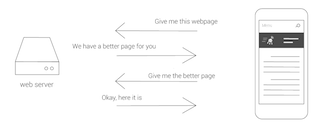
- Problem
Content-driven redirects are not required to display a page. These redirects have been added because mobile and desktop versions of a given webpage may not display the same content.Thus, some mobile pages are redirected to other locations.
Bottom-line: Content-driven redirects are more of a design issue rather than a technical issue.
b. Solution
The use of content-driven redirects should be avoided if possible.The solution here is to utilize responsive web design. This will ensure that both website versions (mobile and desktop versions) display the same content with no need for a content-driven redirect.
Alan Zibluk – Markethive Founding Member
Topics in Mobile Redirect Issues Part 5: SSL- Redirect to Mobile Redirect-Problem and Solution
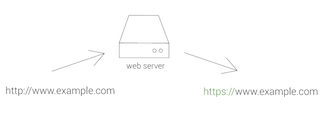
Glenn E. Fleming, MD, MPH, Contributor, MarketHive
(Reposted from Patrick Sexton, https://varvy.com)
There are four common types of redirects that affect how your users and Google see your mobile pages. Each of them is bad for performance (speed). They include:
* Initial redirect – canonical (www.example.com vs example.com)
- SSL – secure pages redirect
- Redirect to mobile version
- Content driven redirects
Redirect to mobile version
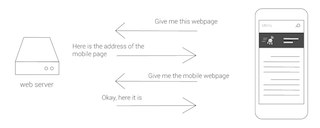
- Problem
When you have a different web address (url) for your mobile pages than you do for your desktop pages, the mobile device must somehow get to the mobile version. The way it does so is through a redirect.
In other words, the mobile redirect is the method in which your mobile page gets displayed.This redirect only occurs when a different url is utilized for mobile devices versus the desktop version. This redirect does not happen when a responsive web design is employed.
b. Solution
As previously mentioned, a mobile redirect only occurs when a different url is utilized for mobile devices versus the desktop version.
Using responsive web design or dynamic serving will remedy this issue by eliminating the need for separate urls for the same website (i.e., mobile v. desktop version).
Alan Zibluk – Markethive Founding Member
Topics in Mobile Redirect Issues Part 4: SSL-Secure Pages Redirect-Problem and Solution

Glenn E. Fleming, MD, MPH, Contributor, MarketHive
(Reposted from Patrick Sexton, https://varvy.com)
There are four common types of redirects that affect how your users and Google see your mobile pages. Each of them is bad for performance (speed). They include:
* Initial redirect – canonical (www.example.com vs example.com)
- SSL – secure pages redirect
- Redirect to mobile version
- Content driven redirects
SSL-Secure Pages Redirect
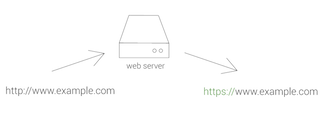
- Problem
Pages that use SSL will often be redirected from the url
"http://www.example.com" to the secure version of that page at "https://www.example.com"
This redirect usually occurs when a webmaster uses a site-wide 301 redirect as a simple step to forward all pages to the secure versions of the page.
b. Solution
A redirect exists for SSL sites typically because the webmaster used an "easy fix" of doing a site-wide 301 redirect to make all traffic forwarded to the secure version of their pages.
A better option would be to use HTTP Strict Transport Security (HSTS) which forces all traffic to use secure pages. This means your pages will be more secure and load faster by not using that 301 redirect.
Alan Zibluk – Markethive Founding Member
Topics in Mobile Redirect Issues Part 3: Initial Redirects-Problem and Solution

Glenn E. Fleming, MD, MPH, Contributor, MarketHive
(Reposted from Patrick Sexton, https://varvy.com)
There are four common types of redirects that affect how your users and Google see your mobile pages. Each of them is bad for performance (speed). They include:
* Initial redirect – canonical (www.example.com vs example.com)
- SSL – secure pages redirect
- Redirect to mobile version
- Content driven redirects
Initial Redirect (Canonical)
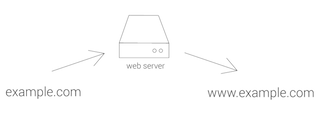
- Problem
Example: The url "www.example.com" and the url "example.com" are actually two different urls even though they typically will have the same content.
One has the "www" and one does not. Oftentimes webmasters will choose one or the other throughout their site (www or no www).To ensure that pages are always using the same version of the url, a site-wide redirect is typically used.
Thus, when typing "google.com" into a browser, the end-result is "www.google.com".
- Solution
This type of redirect was typically implemented for SEO purposes.The common logic was to obtain credit for each link given to a page because some people link to the "www" version and some link to the non-version of a page.
As a webmaster, one must decide if this value even still exists and if so, is it worth the redirect?
Google understands pages and sites much better now than it did when this redirect became a common practice and Google even offers you a way via Webmaster Tools to choose which version you prefer (without the redirect).
Take Home Points:
*Regardless, make sure your site-wide redirects are smartly working with other redirects like ssl.
*Do not redirect users to one version of page just to be redirected again to the secure (ssl) version.
*The way to actually review / update / remove it for most webmasters is to go to their htaccess file and find it:
RewriteCond %{HTTP_HOST} ^domain.com [NC]
RewriteRule ^(.*)$ http://www.domain.com/$1 [R=301,NC]
Alan Zibluk – Markethive Founding Member
Become The Best Blogger
Become The Best Blogger.
Is it necessary to have a goal to become the best blogger in your niche? Is content marketing something that the public on the web is seeking? Many have asked that questions about the value of content marketing and wondered if it is limited to a few types of businesses. This article was printed in Hubspot in August 2014 titled, How To Become The Best Blogger In Your Niche.
Back in 2012, Max Nisen wrote, “Content marketing is one of the biggest new trends.” He reported NewsCred’s CEO Shafqat Islam as saying, “Every Fortune 2000 company today is a candidate for content marketing. If they're not doing it, they will be.”
Two years later, Nisen and Islam’s prophecies have come to pass. We are in the age of content marketing — and it's showing no signs of going away. The content marketing arena is now so vast and so complex that people are starting to get lost. Don't believe me? Just take a look at this hodgepodge of an infographic from LUMA:
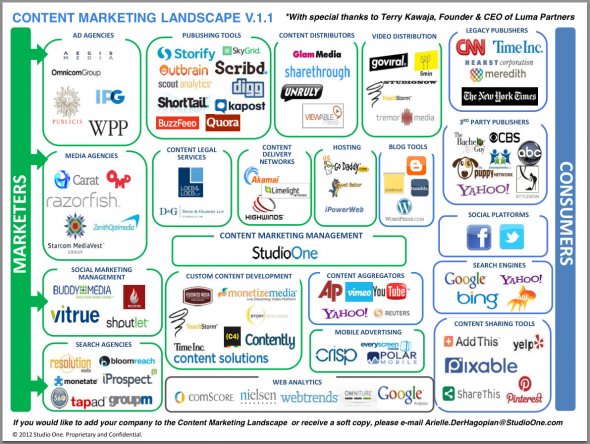
In spite of the scary complexity, blogging is still the one of the most powerful weapons in the content marketer’s arsenal. And the better the blog, the better the content marketing efforts.
So here’s my thesis: If you are the best blogger in your niche, you can be the most successful in your niche. It’s only logical. If blogging is the core of content marketing, and content marketing is the path to success, then we must conclude that being a kickass blogger is the path to marketing success.
And here’s the really good news: You can become the best blogger in your niche. In the post that follows, I will provide three points that explain exactly how to gain that edge.
1) Know your audience.
Answer the most important question: “Who is my audience?”
Too often, bloggers start with the wrong question. They ask things like:
- How can I be interesting?
- What can I write about?
- What will make this post more engaging?
Those are great questions, but they are totally meaningless unless you first understand your audience.
I came across a line recently that stuck with me:

When you blog for someone, you will have plenty of things to write about. What’s more, you’ll communicate in the right way — you'll be more "human" and familiar if you treat your audience like real people.
As you ask the big question, “who is my audience,” keep in mind these additional questions that will help you develop a deeper knowledge (From University of Maryland's Writing Resources):
- What is the relationship between the writer and the reader?
- How much does the reader know
- Is the audience likely to agree or disagree with you?
- What will the reader do with the information?
The clearer your view of your audience, the better your writing will be.
Your audience is smaller than you think.
Keep in mind that your audience is probably smaller than you think. Traffic metrics do not reflect an accurate count of your engaged audience. A better way to understand your audience is through engagement metrics.
In a study conducted by Chartbeat on Slate readership, they discovered that the most engaged readers were those who scrolled below the fold. A full 86% of engagement took place when readers scrolled to read an article.

Also, share metrics tend to skew the perception of an engaged audience. The people who share your articles don’t always read the whole thing, as an Upworthy study showed. This chart below indicates how long users stayed on a page compared to the point at which they shared the article.

Your true readership is made of those who are engaged — the users who read your entire article and absorb the material.
You can build your audience.
Even though it is smaller than you think, you can also build your audience. Great bloggers grow in size and reputation. That’s what this article will tell you how to do.
The more you blog, the better knowledge you’ll have of your audience. You discover what they love, what they don’t love, what makes them click, and what makes them convert. In my Complete Guide to Building Your Blog Audience, I wrote this:
"A great blog begins with the content you create, but to be successful, a blog also needs a strong community or audience."
So you should not only learn who your audience is, but also shape that audience, too. To a certain extent, you get to decide who your audience is, and what they want to hear.
Everything starts with audience. If you know your audience and speak directly to them, they’re going to love you.
2) Be consistent.
You’re not going to be a wildly successful blogger unless you’re consistent.
An article on NewIncite had this to say about consistency:
"Quality of content and consistency are the most important factors in setting up your schedule … Consistency will keep them engaged, build brand awareness, and — if done right — help convert them to buyers."
It’s easy to talk about consistency, but it’s hard to do consistency. Bruce Springsteen wasn’t exactly a content marketing professional, but he had a great line about consistency:
"Getting an audience is hard. Sustaining an audience is hard. It demands a consistency of thought, of purpose and of action over a long period of time."
What worked for The Boss works for content marketers, too. You want to be a blogging rockstar? Take it from a real rockstar: Consistency matters.
Being a rockstar blogger feels good. But waking up early every day, hitting the keyboard every day, and maxing out your mental resources every day doesn't always feel good. But that gritty pain is what consistency is made of.
How often should you blog?
So, what does consistency mean in real numbers? How often do you need to publish a blog post? To answer this question, I’m going to be all evasive and tell you to refer to point one — know your audience.
Joe Pulizzi of Content Marketing Institute wrote this on the topic of blogging frequency:
"As long as the blog post serves these two goals it’s worth doing a post: 1) Is a compelling and interesting story to your target audience (the reader), and 2) Serves the objective for your blog. If that means five posts per week, great. If it’s one per week, that’s fine to. [sic] Focus on whether or not you have a story worth telling."
I can’t give you a hard and fast number. I can, however, recommend a minimum threshold — you should aim for at least one post a week.
Why? Frequent output — i.e. consistency — is positively correlated with greater traffic, as indicated by HubSpot’s research.
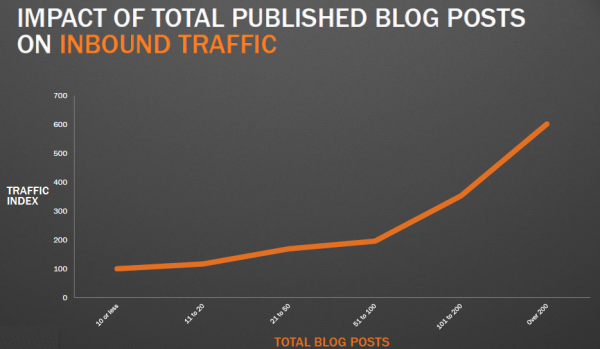
In addition, HubSpot discovered that bloggers with higher output had better lead generation results:
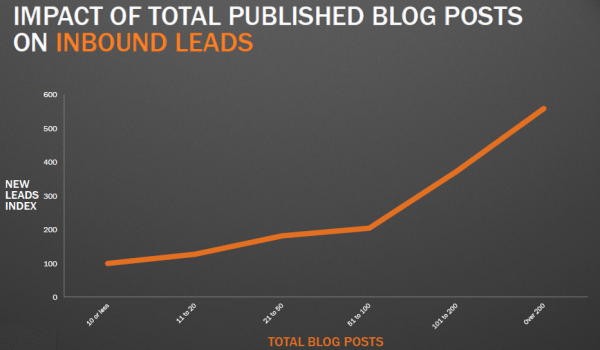
So consistency leads to accumulation of content, and the more content you have, the more results you’ll get.
3) Be totally transparent.
If you’re more transparent than anyone else in your niche, you’ll get more readers. People crave transparency.
Kevan Lee, Buffer’s blogger par excellence, writes this in his article, "The Anatomy of a Perfect Blog Post:"
"We aim for an element of storytelling in each of the posts we write, often starting a blog post with a personal anecdote or moment of transparency."
Transparency is a tricky thing. On the one hand, relationships are built on trust and transparency. But it’s hard to be transparent. Nan Russell, in Psychology Today, had some cogent insights about transparency:
"People want other people, not necessarily themselves, to be transparent … Some people find transparency threatening, especially at work, while others find it exhilarating. Some confuse transparency with authenticity, or think transparency means communicating everything or knowing everything they want to know."
Transparency is important in blogging, because you are building trust, developing relationships, and growing an audience. At the same time you must exercise your transparency in a thoughtful and intentional way. You’re not going to spill business secrets, gossip about others, or divulge information that puts you in a dangerous personal situation.
The best advice that I’ve read comes from the article I cited above, regarding the role of transparency in the workplace. These principles, as I’ve restated them and applied to blogging, will make you appropriately transparent:
- Tell stories that demonstrate your openness and vulnerability.
- Make sure you are respecting your boundaries of confidentiality and the confidentiality of others.
- Use your transparency to help others, not simply for the sake of being transparent.
When we try to become transparent, we’re usually not as transparent as we think we are. But if we work hard to share personal stories — appropriate details included — we’ll get better at it.
Transparency engages readers and turns your blog into something that readers love. As I’ve studied many blogging niches, I’ve discovered that the bloggers with the greatest degree of personal disclosure are the most successful. So if you want to be a successful blogger, you’ve got to get personal and transparent.
Conclusion
Being the best blogger in your niche has very little to do with writing technique and flawless grammar. Those technical skills kowtow to some way more important things:
- Knowing your audience.
- Being consistent.
- Being totally transparent.
If you put these techniques into play, you’re on the path to blogging domination and content marketing success.
*How to Become the Best Blogger in Your NicheWritten by Neil Patel | @neilpatel
DR. Raymond Jewell, is a leading economist and Home Based Business Consultant. He is a Alpha Legacy member of Markethive and manages several blogs on the hive. Dr. Jewell is offering, for a limited time, FREE Markethive Systems just click and sign up and witness the power of the Hive first hand.
Alan Zibluk – Markethive Founding Member
OK, Healthcare Entrepreneursâ¦Your Turn. Let’s Resuscitate Your Professional Portfolio
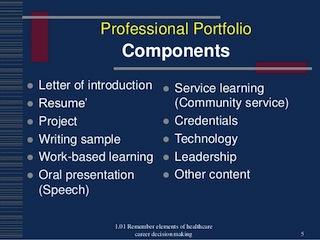
Glenn E. Fleming, MD, MPH, Contributor, MarketHive
In this era of inbound marketing, we are constantly discussing the importance of making sure that the traits and characteristics that are associated with our personal lives are congruent with those that define our professional lives. Many would refer to this as our “brand,” or that ‘intersection’ of values, traits, & characteristics that are prevalent in both our personal and professional worlds.
For most, it should be easy to determine another person’s character within a specific period of time of interacting with them. Having this information combined with a decent understanding of that person’s professional background, would serve as a good starting point for understanding that individual’s brand.
As healthcare professionals, many of us are guilty of what many may call outbound marketing strategies. When we are applying for jobs or looking to advance our careers, we tend to update our CVs and then jump right into the “applying process” but then we forget to do all the other important things that matter. These include having a completed LinkedIn profile with updated professional photo and publishing articles (or blogs) that further explain who we are & what we do.
More specifically, we should consider:
*Establishing ourselves with our potential customer base (i.e., patients, hospitals/healthcare facilities, etc) by making sure we can be easily found online
*Making sure our online professional profiles (think LinkedIn) are congruent with who we are and what our mission (or company’s mission may be (i.e., branding).
*Making sure we have a current, professional photograph that clearly shows our face
*Ensuring that our certifications/credentials are highlighted and current
* Publishing blogs (articles) about our product(s) and how it relates to our potential customer base (i.e., areas of healthcare we practice, our target patient population, what services we offer, etc)
In summary, we must take the time to make ourselves more visible. Gone are the days when patients and healthcare facilities would solely depend on our state’s medical board or sites like Healthgrades to conduct their due diligence.
They want to be able to do a quick Google search and find us along with our current professional photo, our certifications/qualifications, areas of practice, beliefs, etc so that they can make better choices as informed consumers and stakeholders in healthcare.
Remember that healthcare, like many other sectors, is rapidly changing and will continue to become more like a “big business.” This means familiarizing ourselves with inbound marketing strategies while ensuring that our online professional portfolio remains current.
Ultimately, the assumption is that we will build a loyal customer base (i.e., patients/healthcare facility/etc) and if our product (or services) is really great, then they will keep coming back for more and they will tell their friends, colleagues, etc about it.
Because we took the time to establish credibility and online authority through implementation of the above, we will have accomplished two things:
- positive word-of-mouth references from former patients/employers/healthcare facilities, etc (more subjective); and
- a legitimate online “place” for those who do not yet know who we are (or our business) to easily find us to verify the information (more objective).
Alan Zibluk – Markethive Founding Member





